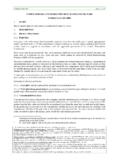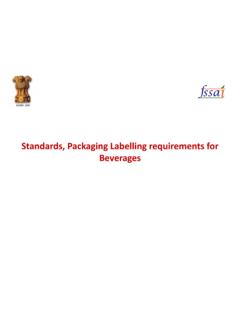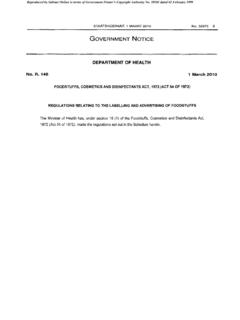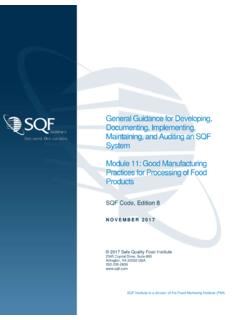Transcription of EU LEGAL REQUIREMENTS FOR IMPORTS OF …
1 EU LEGAL REQUIREMENTS FOR IMPORTS OF FRUITS AND VEGETABLES ( a suppliers GUIDE) Andrew Graffham Fresh Insights no. 1, Report series for This publication was funded by the Department for International Development (DFID) of the Government of the United Kingdom as part of a project entitled Small-scale producers and standards in agrifood supply chains: Phase 2, 2005-2008 (AG3815) . However, the views expressed may not necessarily reflect that of official DFID and UK Government policy. Citation: Graffham, A. (2006). EU LEGAL REQUIREMENTS for IMPORTS of fruits and vegetables ( a suppliers guide). Fresh Insights no. 1, DFID/IIED/NRI, Corresponding author: Andrew Graffham, Natural Resources Institute, UK. CONTENTS Contents i List of tables iii Glossary iv Definitions v Acknowledgement vi Summary 1 SECTION 1: INTRODUCTION AND BACKGROUND INFORMATION ON REGULATORY REQUIREMENTS FOR GLOBAL TRADE IN FRESH FRUITS AND VEGETABLES 2 Scope of the guide 2 How to use this guide 2 Food safety as a driver for change in global trade 2 Harmonisation of international law under WTO 3 Harmonisation of EU regulatory REQUIREMENTS 3 Who is responsible for ensuring food safety?
2 4 EU market REQUIREMENTS wholesale versus retail 4 SECTION 2: MINIMUM LEGAL REQUIREMENTS FOR EXPORT OF FRESH FRUITS AND VEGETABLES TO THE EU 5 Does EU food law apply to food businesses outside the borders of the EU? 5 SANITARY AND PHYTOSANITARY (SPS) MEASURES 5 Comparison of import controls for products of non-animal and animal origin 5 Vertical traceability (EC/178/2002) 6 Hygiene rules for foods of non-animal origin (EC/852/2004) 8 Summary of hygiene REQUIREMENTS for primary production of fresh fruits and vegetables as specified under Annex IA of EC/852/2004 9 Summary of hygiene REQUIREMENTS for minimally processed (fresh or pre-cut) fruits and vegetables as specified under Annex II of EC/852/2004 10 Microbiological criteria for foodstuffs (EC/2073/2005) 13 Safe and effective use of pesticides 15 Pesticides banned in the EU (Directive 79/117/EEC) 15 Pesticides approved for use within the EU (Directive 91/414/EEC)
3 16 Harmonised MRL s for pesticides (EC/396/2005) 17 Chemical contaminants in food (EC/466/2001) 19 Phytosanitary measures (Directive 2000/29/EC) 20 Wood packaging (Directive 2004/102/EC) 21 Special restrictions on import of food of non animal origin (EC/882/2004) 21 TECHNICAL BARRIERS TO TRADE (TBT) MEASURES 22 Market grade standards (EC/2200/1996 & EC/1148/2001) 23 Organic production (EC/2092/91 & EC/1788/2001) 25 SECTION 3: EU fruit AND vegetable import REQUIREMENTS AT A GLANCE 26 Minimum LEGAL REQUIREMENTS for export to EU markets applicable to all shipments of fresh fruits and vegetables 27 Additional REQUIREMENTS applicable to fresh-cut (minimally processed) fruits and vegetables 36 Additional REQUIREMENTS applicable for commodities covered by market grade standards as defined under EC/2200/1996 37 Additional REQUIREMENTS applicable for organic fruits and vegetables as defined under Regulations EC/2092/91 & EC/1788/2001 38 REFERENCES 39 EU Regulations 39 UK Regulations 40 EU Directives
4 40 EU Commission Decisions 41 EU Commission Communications & White papers 41 Guidance on interpretation of EU food law 41 USEFUL WEBSITES 42 LIST OF TABLES Table 1. Comparison of EU import controls for products of animal and non-animal origin 7 Table 2. Food safety and process hygiene criteria for ready to eat sprouted seeds and fresh-cut fruits and vegetables as specified under EC/2073/2005 14 Table 3.
5 List of pesticides banned under directive 79/117/EEC 16 Table 4. Maximum residue levels for chemical contaminants in food as defined under EC/466/2001 19 Table 5. List of products of non-animal origin subject to market grade standards under EC/2200/1996 24 List of tables given as sub-sections of section 3: Table Minimum LEGAL REQUIREMENTS for export to EU markets applicable to all shipments of fresh fruits and vegetables 27 Table Additional REQUIREMENTS applicable to fresh-cut (minimally processed) fruits and vegetables 36 Table Additional REQUIREMENTS applicable for commodities covered by market grade standards as defined under EC/2200/1996 37 Table Additional REQUIREMENTS applicable for organic fruits and vegetables as defined under Regulations EC/2092/91 & EC/1788/2001 38 GLOSSARY BRC British Retail Consortium CAC Codex Alimentarius Commission CFU Colony Forming Unit DGSANCO Directorate General for Health and Consumer Protection EC European Commission EU European Union EUREPGAP European Retailers Protocol for
6 Good Agricultural Practice FAO Food and Agriculture Organisation FHD First Harvestable Date FVO Food and Veterinary Office GAP Good Agricultural Practice GATT General Agreement on Tariffs and Trade GHP Good Hygienic Practice HACCP Hazard Analysis Critical Control Point IPPC International Plant Protection Convention ISPM International Standard for Phytosanitary Measures LOD Limit of Detection MDF Medium Density Fibreboard MRL Maximum Residue Limit NPPA National Plant Protection Authority NRI Natural Resources Institute PHI Pre Harvest Interval SPS Sanitary and Phytosanitary TBT Technical Barriers to Trade UK United Kingdom WHO World Health Organisation WTO World Trade Organisation DEFINITIONS Primary production means the production, rearing or growing of primary products including harvesting, milking and farmed animal production prior to slaughter.
7 It also includes hunting and fishing and the harvesting of wild products. Post-harvest processing refers to any procedure carried out on fruits or vegetables after harvesting (other than simple sorting and grading), this would include processes such as washing, trimming and cutting. Food of non-animal origin refers to fruits, vegetables, cereals, roots, tubers, nuts, edible fungi, drinks prepared from fruit or vegetable products, spices, condiments and food of mineral origin such as salt. Food of animal origin includes all forms of meat, fish, shellfish, gastropods, crustacea, milk and any products prepared from these foods. Vertical legislation refers to legislation that deals with specific products, currently the EU has 9 vertical Directives dealing with cocoa, chocolate, sugars, milk products, honey, fruit juices and fruit jams.
8 Horizontal legislation refers to legislation on issues that are common to all foodstuffs such as hygiene, labelling, additives and chemical residues. EU Regulation the text of the law must be applied directly by all EU member states without changing REQUIREMENTS or criteria. EU Directive the text of the law must be interpreted and incorporated into national law by each member state, this allows member states flexibility to make changes to criteria such as setting national tolerances for chemical contaminants rather than using values given in the EU Directive. EU Decision a commission decision is a specific time limited measure for additional official controls, and is normally made in response to recognition of a risk to human, plant or animal health via an existing or emerging risk. EU Communication communications have no LEGAL validity but serve for the EU to give opinions, guidance or indications of policy.
9 Sanitary and Phytosanitary (SPS) measures refers to all measures intended to protect human, animal or plant health. Technical Barriers to Trade (TBT) measures refers to non-health related measures such as marking, labelling, packaging, market grade standards and conformity assessments to EU standards. Due diligence defence is a LEGAL defence whereby the EU food business (importer or retailer) is able to demonstrate in court that they have taken all reasonable precautions and exercised due diligence in trying to avoid breaking the LEGAL REQUIREMENTS . This defence is important for EU food businesses in terms of determining negligence and responsibility for insurance purposes. Fully documented food safety management systems with evidence of compliance in the form of detailed records and independent verification form a strong due diligence defence hence the interest by EU importers and retailers in private assurance schemes such as EUREPGAP and the BRC global technical standard.
10 Precautionary principle Sanitary and phytosanitary measures are intended to be based on sound scientific evidence, however in emergencies it may not be possible to wait for scientific evidence to be available. In these cases the EU invokes the precautionary principle whereby immediate action can be taken in the absence of scientific evidence and justified at a later date when the evidence becomes available. Traceability refers to the ability to trace and follow a food or substance intended to be incorporated into a food through all stages of production, processing and distribution. In practice this means a system of record keeping and documentation by food businesses to enable tracing or tracking of the movement of a product or ingredient through every stage of the food chain. Vertical traceability refers to the ability to trace movement of food at different stages of the market chain.




